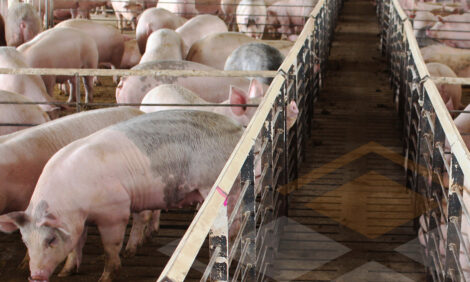



Porcine Ileitis - An Overview
By Jake Waddilove MA, VetMB MRCVS - Ileitis (Porcine Proliferative Enteropathy) is a major disease in pigs occurring throughout the world. It is caused by the bacterium Lawsonia intracellularis. The disease can affect all types of pig production from continuous farrow-to-finish operations through to high health units practising segregated rearing techniques.It appears that the disease can behave differently in different systems due to the timing of exposure to Lawsonia intracellularis. The cost of the disease can be massive. It has been estimated by McOrist et al that the chronic form of the disease causes between 10-25 million pounds (GB Sterling) of economic loss to the UK pig industry each year alone.
Porcine Ileitis
- Ileitis is an extremely common endemic disease globally in pig production
- Economic costs are very high
- Production losses are seen even if little or no scour is seen
- Eradication has not proved possible at a commercial level
- Control is based on medication, management changes, biosecurity and sometimes vaccination
- Good biosecurity is the most cost-effective control and is fundamental in helping other controls. This necessitates the use of a programme including a proven broad- spectrum disinfectant with specific activity against Lawsonia intracellularis (Virkon S7).
| Country | % Positive Farms | % Positive Pigs | Number of Farms Tested |
| USA | 96 | 60 | 405 |
| Great Britain | 95 | 62 | 156 |
| Taiwan | 100 | 71 | 25 |
| Czech Republic | 96 | 66 | 45 |
| Denmark | 94 | 30 | 79 |
| Canada | 95 | 60 | 78 |
The widespread nature of infection suggests the disease is endemic on most farms. It can occur in many forms, but the most common is the chronic form in pigs of 6-20 weeks of age leading to diarrhoea, ill-thrift and poor production.
An acute form can cause sudden death in older pigs. Importantly it has been shown that approximately half of any infected group of pigs developed no visible diarrhoea, but did exhibit gut wall lesions and hence depressed performance (McOrist 2,3, Smith and McOrist 4).
The disease can affect all types of pig production from continuous farrow-to-finish operations through to high health units practising segregated rearing techniques. It appears that the disease can behave differently in different systems due to the timing of exposure to Lawsonia intracellularis.
The cost of the disease can be massive. It has been estimated by McOrist et al that the chronic form of the disease causes between 10-25 million pounds (GB Sterling) of economic loss to the UK pig industry each year alone.
Spread of Disease
The precise method of spread of the disease is unclear. Pigs spread the disease and at a farm level oral ingestion of faeces is the primary method of infection. Pigs shed infective organisms for several weeks post-infection, and sows may well develop a carrier state (McOrist1) Under the right conditions the organism can survive in a pig house for at least 1 week, possibly longer. Passive transfer of faeces on boots or fomites, such as rodent’s feet, can transfer infection around a unit. To date an active role of infected vectors of other species has not been shown.
Control
Attempts to eradicate Ileitis from a farm have been described (Johansen et al5) but success has been very low to date. It is therefore essential to develop a comprehensive control programme to reduce the high ongoing costs of this disease. This programme will include medication, management changes and biosecurity measures. A vaccine has been commercially introduced in the USA.
Medication
Although a large number of antibiotics are potentially effective against Lawsonia intracellularis, the most commonly used are Tylosin (Tylan-Elanco), Tiamulin (Tiamutin – Novartis) and Chlortetracycline (various).
If animals are introduced into an infected situation clinical disease can be prevented by administering one of the above medications, usually in food, within 14 days of exposure. The medication period is normally 14 days.
In situations where ongoing disease is causing problems in growers and finishers continuous medication may be required (for at least some of the production period). It has been estimated that if only 6% of the pigs show diarrhoea medication is indicated. High levels of biosecurity (see below) will reduce the frequency, duration and intensity of medication needed.
Management Changes
There are certain changes that will reduce the incidence and severity of Ileitis. These include:
- Adopt all-in, all-out production with terminal biosecurity between batches
- Reduce stressors such as poor ventilation and temperature variations
- Reduce or stop mixing of pigs
- Avoid overstocking
- Reduce stress due to transport – important in 2 and 3 site systems
- Avoid interruptions in feed and water supply
- Reduce feed quality variations
- Control other diseases.
Biosecurity Measures
As the main part of spread is by faeces and infection can persist in unpopulated houses for over a week, terminal disinfection is a vital part of any control programme. It reduces the needs and costs of medication and is the most cost-effective part of most control programmes.
Empty the accommodation between batches. Remove gross organic contamination and then thoroughly wash the pens utilising a heavy-duty detergent (Biosolve – DAHS). Any moveable equipment should have been removed and treated in the same way. Next disinfect all areas using an agent with proven efficacy against Lawsonia intracellularis, such as Virkon S (DAHS). Water systems should be drained and sanitised using the same agent. Establish a good routine of foot dips and wheel washes between houses. Remember boots must be clean before disinfecting (Amass 6).
Continuously populated buildings are more difficult to control. Attempt to establish a rolling biosecurity programme based on the above. Periodic production breaks with terminal disinfection as above coupled with strategic medication can provide good control under these circumstances. Again in continuous units look at the use of footdips, wheel washes and disinfection of shared equipment between each house or group of pigs. Again the chosen agent would be Virkon S.
Vaccinations
A water-administered vaccine has been released in the US (Enterisol Ileitis – Boehringer Ingelheim). This has had promising results in the control of Ileitis and pigs can be vaccinated at any age over 3 weeks. Timing of vaccination is critical as protective immunity takes 3-4 weeks to develop. Reducing the challenge to the pig by good biosecurity helps prevent breakdowns in vaccinated pigs, especially during the development of immunity.
Further Reading
Information on Porcine Ileitis, along with over 130 other swine diseases, is available in our Quick Disease Guide Section.More on DuPont Animal Health Solutions
References
- McOrist et al (2003). The Pig Journal 51, 26-33.
- McOrist et al (1993). Infection and Immunity, 61, 4286-4292.
- McOrist et al (1996). Veterinary Record 139, 616-618.
- Smith S.H. and McOrist (1993) Research in Veterinary Sciences 62, 6-10.
- Johansen M. et al (2002). Proceedings 17th International Pig Veterinary Society Paper 52.
- Amass S.F. et al (2001). J Swine Health Production 9 (3) 121-123.
- Department of Veterinary Pathology, University of Edinburgh, Scotland - In vitro susceptibility of Lawsonia Intracellularis to major disinfectants including Virkon S – (Antec Virkon S proven effective at 1:100 dilution rate).






